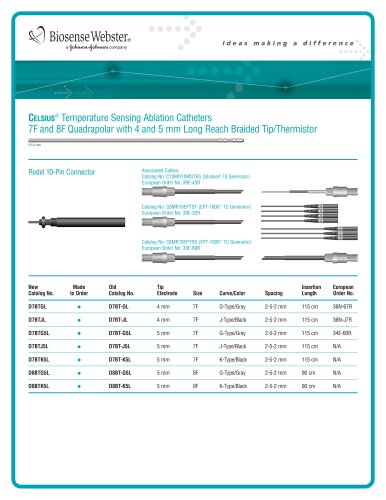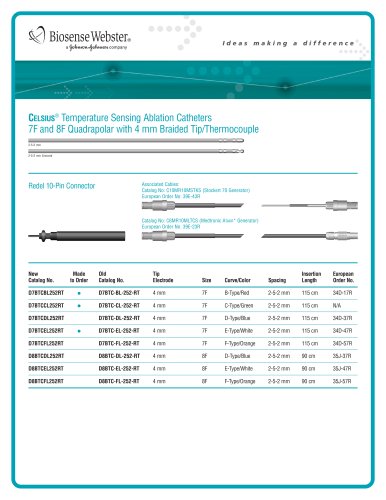
Excertos do catálogo

Comparison of 12 and 56 Hole Electrodes for Open Irrigated Radiofrequency Ablation in a Canine Thigh Muscle Preparation: Improvement in Thrombus Reduction with 56 Small Irrigation Holes Hiroshi Nakagawa, MD, PhD Professor of Medicine Director, Clinical Catheter Ablation Program; Director, Translational Electrophysiology Heart Rhythm Institute, University of Oklahoma Health Sciences Center Oklahoma City, OK Introduction During radiofrequency (RF) ablation, thrombus develops at sites of high electrode-tissue interface temperature.1-4 Saline irrigation through “open irrigated” electrodes cools the electrode-tissue interface, reducing the risk of thrombus while allowing greater RF power in areas of low blood flow (less convective cooling).4-7 There are at least two limitations for the use of saline irrigation. One limitation is the risk to deliver a relatively large volume of saline to the patient during an ablation procedure with a large number of RF applications or a long procedure time. The second limitation is the requirement to provide irrigation flow to the electrode-tissue interface for any electrode-tissue contact orientation. This may be best achieved by providing irrigation flow around the entire ablation electrode. We hypothesized that placing a larger number of smaller holes around the entire electrode would reduce the risk of thrombus formation and decrease the required irrigation flow rate. Purpose The purpose of this study was to test two new irrigation electrode designs to evaluate thrombus formation using an established canine model. Methods Irrigation Ablation Catheters Catheter Electrode #1(Therapy™ Cool Path™ Duo Catheter, St. Jude Medical, Inc., Figure 1, left panel): This open irrigation catheter has a 7Fr tip electrode, 4mm in length with 12 irrigation holes (diameter 0.015”). Six irrigation holes are located around the circumference of the electrode at 1 mm from the tip and the other 6 holes are located around the circumference of the electrode at 1 mm from the proximal edge of the electrode. This electrode is designed to provide irrigation close to both the electrode tip and the proximal edge. Catheter Electrode #2 (ThermoCool® SF Catheter, Biosense Webster, Inc., Figure 1, right panel): This open irrigation catheter has an 8 Fr tip electrode, 3.5 mm in length with 56 very small holes (diameter 0.0035”) positioned around the entire electrode. 12 Irrigation Holes (Diameter: 0.015") 56 Irrigation Holes (Diameter: 0.0035") The surface area of the ablation electrode for Catheter #1 (12 holes) and Catheter #2 (56 holes) is comparable (33.6 mm2 vs. 32.4 mm2). Therefore, at any given RF power, electrode orientation and contact force, the power delivered to the tissue is expected to be similar. Both catheters contain a thermocouple embedded within the tip electrode for monitoring electrode temperature during ablation. Irrigation Flow Rates Between RF applications, both electrodes were irrigated through the central lumen and exiting the ablation electrodes at a flow rate of 2 ml/min using heparinized (1 U/ ml) normal saline (0.9%NaCl) at room temperature. During RF application, the irrigation flow rate was increased for each of the electrodes: Catheter Electrode #1 (12 Holes) - 17ml/min (beginning 3 seconds before and continuing until 3 seconds after each RF application) for RF applications at 30, 40 and 50 Watts. Catheter Electrode #2 (56 Holes) – 8 ml/min (beginning 3 seconds before and continuing until 3 seconds after each RF application) for RF applications at 30 Watts, and 15 ml/min flow rate for RF applications at 40 Watts and 50 Watts.
Abrir o catálogo na página 1
Canine Thigh Muscle Preparation Four mongrel dogs weighing 25 to 28 kg were anesthetized with sodium pentobarbital (25 mg/kg) and ventilated mechanically with room air. The right carotid artery was cannulated for monitoring arterial pressure. Each dog was placed on its right side. A 20-cm skin incision was made over the left thigh muscle. The skin on each side of the incision was dissected free of the connective tissue. The skin edges were raised to form a cradle that was filled with heparinized blood (activated clotting time >350 seconds) from the same animal at 37-38 ºC.1, 4-7 and the...
Abrir o catálogo na página 2
#2 (56 Holes) for the perpendicular orientation (median 108 vs. 106 Ohms, p=NS) or the parallel orientation (medi- an 114 vs. 112 Ohms, p=NS, Figure 3), consistent with the similar surface area for the two electrodes. There was no impedance rise during any of the RF applications (30, 40 or 50 Watts) using either of the two catheter electrodes. The peak electrode temperature was significantly lower with Catheter Electrode #2 (56 Holes) at each power level and electrode-tissue orientation (perpendicular and paral- Peak Electrode Temperature
Abrir o catálogo na página 3
Tiiiue Temperature at 3mm Depth I Tissue Temperature at 7mm Depth j IZHoles ti'-iolcj TzHolesl ^SHales Union Diameter lZHoln UHalci Lesion Depth I 2 Hole J 56HOI01 IZHtJiCi. Holes Perpendicular Electrode-Tissue Orientation (Figure 10A) Using Catheter Electrode #1 (12 Holes), a tiny thrombus (<1mm3) occurred with 1/8 RF applications at 30 Watts. A tiny thrombus (1/8) or larger thrombus (>1mm3, 4/8) occurred with 5/8 RF applications at 40 Watts. A tiny thrombus (2/8) or larger thrombus (5/8) occurred with 7/8 RF applications at 50 Watts. In all 12 RF applications with thrombus, the thrombus...
Abrir o catálogo na página 4
HHultj SSHijlm UHck's 5SHylrJ IJHok-s S&Hok-s The initial impedance, tissue temperatures at 3 mm and 7 mm depths, lesion size and the incidence of steam pop were similar between the two catheter electrodes at 30, 40 and 50 Watts, in both perpendicular and parallel orien- tation. This suggests that the RF power delivered to the tissue (tissue power) was similar between the two catheter electrodes, presumably due to the similar surface area of However, the electrode-tissue interface temperature and the incidence of thrombus were significantly lower for the Catheter Electrode #2 (56 Holes),...
Abrir o catálogo na página 5Todos os catálogos e folhetos técnicos Biosense Webster
-
PentaRay nav
2 Páginas
-
CATALOGUE 2018
130 Páginas
-
Ep procedure Documentation
2 Páginas
-
CARTO® 3 System
3 Páginas
-
Atrial Fibrillation Fact Sheet
3 Páginas
-
THERMOCOOL® SMARTTOUCH® Catheter
2 Páginas
-
C ARTO ® 3 System
3 Páginas
-
AcuvNav? Catheter
4 Páginas
-
AcuNav? Ultrasound Catheter
4 Páginas
-
Preface® Braided Guiding Sheaths
2 Páginas
-
Webster® HIS Catheter
2 Páginas
-
Webster® CS Uni-Directional Catheter
2 Páginas
-
DecaNav? Catheter
3 Páginas
-
PentaRay® NAV Catheter
6 Páginas
-
Lasso® NAV Eco Catheter
6 Páginas
-
ThermoCool® Catheters
4 Páginas
-
SFOrderCard
2 Páginas
-
ThermoCool ®
2 Páginas
-
Carto® System Insight Magnified
6 Páginas
-
PREFACE Braided Guiding Sheaths
1 Páginas
-
COOLFLOW Pump
1 Páginas
-
Tip Electrode Types
1 Páginas
-
Fixed Curves
6 Páginas
-
PENTARAY
1 Páginas
-
WEBSTER 6F Fixed Curve Catheter
1 Páginas
-
WEBSTER 6F Hexapolar Catheter
8 Páginas
-
WEBSTER 6F Quadrapolar Catheter
8 Páginas
-
WEBSTER 5F Quadrapolar Catheter
8 Páginas
-
WEBSTER Decapolar Catheter
1 Páginas
-
WEBSTER Octapolar Catheter
1 Páginas
-
WEBSTER 7F Hexapolar Catheter
1 Páginas
-
HALO XP
1 Páginas
-
ACUNAV brochure
4 Páginas
-
CARTO XP System specifications
4 Páginas
-
CARTO XP EP Navigation System
2 Páginas
-
CARTO RMT
4 Páginas
-
EZ STEER
6 Páginas
-
Stockert 70
1 Páginas
-
THERMOCOOL
6 Páginas
-
ACUNAV
4 Páginas
-
CARTO XP EP
4 Páginas
Catálogos arquivados
-
CATALOGUE 2015
140 Páginas


















































































